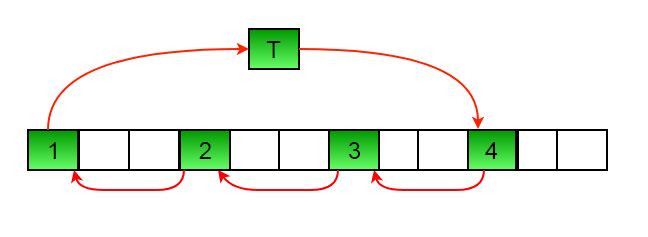Python Program for array rotation
Write a function rotate(ar[], d, n) that rotates arr[] of size n by d elements.
Rotation of the above array by 2 will make array

METHOD 1 (Using temp array)
Input arr[] = [1, 2, 3, 4, 5, 6, 7], d = 2, n =7 1) Store d elements in a temp array temp[] = [1, 2] 2) Shift rest of the arr[] arr[] = [3, 4, 5, 6, 7, 6, 7] 3) Store back the d elements arr[] = [3, 4, 5, 6, 7, 1, 2]
Time complexity : O(n)
Auxiliary Space : O(d)
METHOD 2 (Rotate one by one)
leftRotate(arr[], d, n)
start
For i = 0 to i < d
Left rotate all elements of arr[] by one
endTo rotate by one, store arr[0] in a temporary variable temp, move arr[1] to arr[0], arr[2] to arr[1] …and finally temp to arr[n-1]
Let us take the same example arr[] = [1, 2, 3, 4, 5, 6, 7], d = 2
Rotate arr[] by one 2 times
We get [2, 3, 4, 5, 6, 7, 1] after first rotation and [ 3, 4, 5, 6, 7, 1, 2] after second rotation.
Python3
Output :
3 4 5 6 7 1 2
Time complexity : O(n * d)
Auxiliary Space : O(1)
METHOD 3 (A Juggling Algorithm)
This is an extension of method 2. Instead of moving one by one, divide the array in different sets
where number of sets is equal to GCD of n and d and move the elements within sets.
If GCD is 1 as is for the above example array (n = 7 and d =2), then elements will be moved within one set only, we just start with temp = arr[0] and keep moving arr[I+d] to arr[I] and finally store temp at the right place.
Here is an example for n =12 and d = 3. GCD is 3 and
Let arr[] be {1, 2, 3, 4, 5, 6, 7, 8, 9, 10, 11, 12}
a) Elements are first moved in first set – (See below diagram for this movement)
 arr[] after this step --> {4 2 3 7 5 6 10 8 9 1 11 12}
b) Then in second set.
arr[] after this step --> {4 5 3 7 8 6 10 11 9 1 2 12}
c) Finally in third set.
arr[] after this step --> {4 5 6 7 8 9 10 11 12 1 2 3}
arr[] after this step --> {4 2 3 7 5 6 10 8 9 1 11 12}
b) Then in second set.
arr[] after this step --> {4 5 3 7 8 6 10 11 9 1 2 12}
c) Finally in third set.
arr[] after this step --> {4 5 6 7 8 9 10 11 12 1 2 3}
Python3
Output :
3 4 5 6 7 1 2
Time complexity : O(n)
Auxiliary Space : O(1)
No comments:
Post a Comment
Your feedback is highly appreciated and will help us to improve our content.